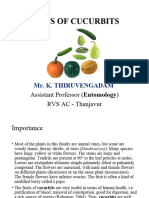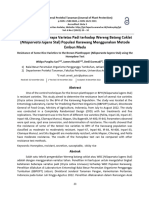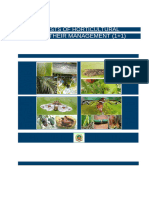0 ratings0% found this document useful (0 votes)
10 viewsTermpaper Part 2
Termpaper Part 2
Uploaded by
Bea Bianca ObnialaThis document summarizes information on various soybean and tomato pests, including the beanfly, black cutworm, pod borer, fruit worm, leafminer, and whitefly. It describes the characteristics, life stages, damages, and management practices for each pest. The beanfly, pod borer, and fruit worm lay eggs that hatch into larvae or maggots that feed on and damage young soybean pods, tomatoes, and leaves. The black cutworm is a nocturnal caterpillar that can severely damage seedlings. Management strategies include removing alternate hosts, practicing sanitation, using pheromones and light frequencies, and planting trap crops to control pest populations.
Copyright:
© All Rights Reserved
Available Formats
Download as DOCX, PDF, TXT or read online from Scribd
Termpaper Part 2
Termpaper Part 2
Uploaded by
Bea Bianca Obniala0 ratings0% found this document useful (0 votes)
10 views3 pagesThis document summarizes information on various soybean and tomato pests, including the beanfly, black cutworm, pod borer, fruit worm, leafminer, and whitefly. It describes the characteristics, life stages, damages, and management practices for each pest. The beanfly, pod borer, and fruit worm lay eggs that hatch into larvae or maggots that feed on and damage young soybean pods, tomatoes, and leaves. The black cutworm is a nocturnal caterpillar that can severely damage seedlings. Management strategies include removing alternate hosts, practicing sanitation, using pheromones and light frequencies, and planting trap crops to control pest populations.
Original Title
TERMPAPER-PART-2
Copyright
© © All Rights Reserved
Available Formats
DOCX, PDF, TXT or read online from Scribd
Share this document
Did you find this document useful?
Is this content inappropriate?
This document summarizes information on various soybean and tomato pests, including the beanfly, black cutworm, pod borer, fruit worm, leafminer, and whitefly. It describes the characteristics, life stages, damages, and management practices for each pest. The beanfly, pod borer, and fruit worm lay eggs that hatch into larvae or maggots that feed on and damage young soybean pods, tomatoes, and leaves. The black cutworm is a nocturnal caterpillar that can severely damage seedlings. Management strategies include removing alternate hosts, practicing sanitation, using pheromones and light frequencies, and planting trap crops to control pest populations.
Copyright:
© All Rights Reserved
Available Formats
Download as DOCX, PDF, TXT or read online from Scribd
Download as docx, pdf, or txt
0 ratings0% found this document useful (0 votes)
10 views3 pagesTermpaper Part 2
Termpaper Part 2
Uploaded by
Bea Bianca ObnialaThis document summarizes information on various soybean and tomato pests, including the beanfly, black cutworm, pod borer, fruit worm, leafminer, and whitefly. It describes the characteristics, life stages, damages, and management practices for each pest. The beanfly, pod borer, and fruit worm lay eggs that hatch into larvae or maggots that feed on and damage young soybean pods, tomatoes, and leaves. The black cutworm is a nocturnal caterpillar that can severely damage seedlings. Management strategies include removing alternate hosts, practicing sanitation, using pheromones and light frequencies, and planting trap crops to control pest populations.
Copyright:
© All Rights Reserved
Available Formats
Download as DOCX, PDF, TXT or read online from Scribd
Download as docx, pdf, or txt
You are on page 1of 3
SOYBEAN PESTS CHARACTERISTIC:
BEANFLY Uon hatching, the larvae
Ophiomyia phaseoli cause damage by boring on
DESCRIPTION; young pods. Seeds are
The maggot is white, about partially eaten which can
3-4 mm long. cause significant yield loss.
STAGES OF MANAGEMENT PRACTICE:
DEVELOPMENT: -Do not plant next to already
Egg:3 days, Larva:12 days, infested crops.
Pupa:7-10 days
DAMAGES
CHARACTERISTICS: BLACK CUTWORM
The feeding creates wounds Agrotis ipsilon
wherein pupation occurs. DESCRIPTION:
MANAGEMENT PRACTICE: Adult moth is dark brown
with white streaks on the
-Removal of alternate hosts. wings. The larvae vary in
color but small orange, half
POD BORER moon spots at the back.
Maruca virata STAGES OF
DESCRIPTION: DEVELOPMENT:
Larvae are pale cream with EGG: 2-4 DAYS
two rows of dark spots at the LARVA:20 DAYS
back. PUPA: 6-7 DAYS
STAGES OF ADULT:5-7 DAYS
DEVELOPMENT; DAMAGE
LARVA:14-18 DAYS CHARACTERISTIC:
ADUL; 1-30 DAYS Young caterpillar eat only
the leaves.
DAMAGES MANAGEMENT PRACTICE;
-Practice sanitation STAGESOF
-Spiders prey on moths DEVELOPMENT:
COMPLETE CYCLE:
TOMATO PESTS DAMAGE
CHARACTERISTIC:
FRUIT WORM Desiccation,premature leaf-
Helicoverpa armigera fall, and cosmetic damage.
DESCRIPTION: MANAGEMENT PRACTICE;
Larvae are up to 40 mm long -The combined use of
and varies in color from pheromones as well as
greenish yellow to red specific light frequency
brown proved to be effective in
STAGES DEVELOPMENT: suppressing the population.
COMPLETE CYCLE
DAMAGES PRACTICE: WHITEFLY
Secondary infections by Trialeurodes vaporarium
other organism may lead to DESCRIPTION:
rotting. Adult are visible to the naked
MANAGEMENT PRACTICE: eyes as white, powdery, and
-Planting sunflower as a trop cotton-like and in aggregate.
crop. STAGES OF
DEVELOPMENT;
LEAFMINER EGG:6-7 DAYS
Liriomyza huidobrensis NYMPH:18 DAYS
DESCRITION ADULT: 21-40 DAYS
Adult is dark colored with DAMAGE
yellow dot on its back and CHARACTERISTIC:
approximately 4mm long. Directly suck sap from the
leaves. Its transmit viruses
and produces a sticky
secretion known as
honeydew, which prevents
crop from functioning
normally.
MANAGEMENT PRACTICE:
-Vcuum sample
-Visual sampling to
determine population
density.
You might also like
- Rice Insect Pest, Classification and IdentificationDocument59 pagesRice Insect Pest, Classification and IdentificationDAR PBDD50% (2)
- Major Pests Of: CottonDocument25 pagesMajor Pests Of: CottonANJITHA K PNo ratings yet
- Jasmine EntoDocument7 pagesJasmine Entoappeteemarose4No ratings yet
- Guava Pests LiteratureDocument34 pagesGuava Pests Literatureprajwalyashu0206No ratings yet
- GUAVA I&pDocument6 pagesGUAVA I&pChandradev KumarNo ratings yet
- INSECTS & PESTS OF GUAVA & PAPAYA by Sneha Shukla-1Document23 pagesINSECTS & PESTS OF GUAVA & PAPAYA by Sneha Shukla-1Sneha ShuklaNo ratings yet
- Pest of Pulses in IndiaDocument14 pagesPest of Pulses in Indiasoyoj17455No ratings yet
- AEN 303 Class 2Document22 pagesAEN 303 Class 2Md IrfanNo ratings yet
- Guava & Papaya Sneha ShuklaDocument11 pagesGuava & Papaya Sneha ShuklaSneha ShuklaNo ratings yet
- Ipm in BananaDocument33 pagesIpm in BananaKesi MamaNo ratings yet
- Rice Pests (Sucking Group)Document10 pagesRice Pests (Sucking Group)Biresh KoleyNo ratings yet
- Cucurbitaceous VegetablesDocument37 pagesCucurbitaceous VegetablesPrasenjit PaulNo ratings yet
- Pest and Disease Management in Horticulture Crops-1Document171 pagesPest and Disease Management in Horticulture Crops-1SHADOW GAMINGNo ratings yet
- Insect Pest of RiceDocument9 pagesInsect Pest of Ricehkami6620No ratings yet
- Lecture 8 & 9Document29 pagesLecture 8 & 9ASHUTOSH MOHANTYNo ratings yet
- Insect Pest of BananaDocument6 pagesInsect Pest of BananaAryan RajNo ratings yet
- EntomologyDocument56 pagesEntomologyGwyneth Dane DangcatanNo ratings yet
- I. Mango: Lecture No.16 Pests of MangoDocument10 pagesI. Mango: Lecture No.16 Pests of MangoSailakshmiNo ratings yet
- Pest of OkraDocument54 pagesPest of OkraPrasenjit PaulNo ratings yet
- Ento 243 Full NotesDocument85 pagesEnto 243 Full NoteskrushidutrkNo ratings yet
- Lect 4 & 5Document29 pagesLect 4 & 5ASHUTOSH MOHANTYNo ratings yet
- Banana pests_LiteratureDocument8 pagesBanana pests_Literatureprajwalyashu0206No ratings yet
- Pop for Management of Rsw in CoconutDocument5 pagesPop for Management of Rsw in Coconutkarthikeyankarthi09011998No ratings yet
- turmeric.... etccDocument21 pagesturmeric.... etccSherin ThomasNo ratings yet
- Pest of Cinnamon WaseemDocument19 pagesPest of Cinnamon WaseemNavneet MahantNo ratings yet
- Pest of PulsesDocument53 pagesPest of PulsesD.P. DeepakNo ratings yet
- Pests of Pulses and Their Management_editedDocument47 pagesPests of Pulses and Their Management_editedanugimmy2001No ratings yet
- ENTOMOLOGYDocument56 pagesENTOMOLOGYGwyneth Dane DangcatanNo ratings yet
- IPM For MangoDocument12 pagesIPM For MangoRoyette SarmenNo ratings yet
- Theory Lecture No.13Document102 pagesTheory Lecture No.13maliniguru2003No ratings yet
- Lecture 6Document19 pagesLecture 6ASHUTOSH MOHANTYNo ratings yet
- Lecture 10 & 11Document52 pagesLecture 10 & 11ASHUTOSH MOHANTYNo ratings yet
- Aen 301 PptsDocument816 pagesAen 301 Pptsjtsreev821111No ratings yet
- Arecanut Insect Pests - VikaspediaDocument4 pagesArecanut Insect Pests - Vikaspediagovreddy2011No ratings yet
- Pest of TomatoDocument25 pagesPest of TomatoAnas MessiNo ratings yet
- Lec1 WordDocument10 pagesLec1 WordViji ThulasiramanNo ratings yet
- Rice Insect Pest & Their ManagementDocument54 pagesRice Insect Pest & Their ManagementRayge HarbskyNo ratings yet
- Cofee Pests Shivanand M. RDocument57 pagesCofee Pests Shivanand M. RShivanand Rangapur100% (1)
- Insect Pest of Mango Banana Apple Sapota and CashewDocument54 pagesInsect Pest of Mango Banana Apple Sapota and CashewManjeet DhNo ratings yet
- 2 Pests of Wheat N BarleyDocument28 pages2 Pests of Wheat N BarleyvjdjNo ratings yet
- Assignment ModelDocument1 pageAssignment ModeldsNo ratings yet
- Diku Jackfruit (Recovered)Document24 pagesDiku Jackfruit (Recovered)purbaliNo ratings yet
- Lec030 - Rose & JasmineDocument10 pagesLec030 - Rose & JasmineCharan MSNo ratings yet
- 2018-Ag-7481 (Pbg-504) Insect Pest of CottonDocument33 pages2018-Ag-7481 (Pbg-504) Insect Pest of CottonQurat ul ainNo ratings yet
- Pests of CucurbitsDocument32 pagesPests of CucurbitsAnas MessiNo ratings yet
- 13. Citrus, Banana, Pomegranate, Litchi and GuavaDocument42 pages13. Citrus, Banana, Pomegranate, Litchi and Guavajatinmishra451No ratings yet
- Theory Lecture No.9Document39 pagesTheory Lecture No.9maliniguru2003No ratings yet
- Pests of Cole CropsDocument18 pagesPests of Cole Cropssusmitapink21124No ratings yet
- 8 Pests of Brinjal and TomatoDocument16 pages8 Pests of Brinjal and TomatoaklockcorelavellNo ratings yet
- Chilli PestsDocument11 pagesChilli PestsSouvik Roy ChowdhuryNo ratings yet
- 6Document189 pages6pratikrajnkeNo ratings yet
- Cruciferous VegetablesDocument46 pagesCruciferous VegetablesPrasenjit PaulNo ratings yet
- Pests of GrapeDocument13 pagesPests of Grapebhagwat chavanNo ratings yet
- Identification of Insect Pests of Sorghum and Their Symptoms of DamageDocument48 pagesIdentification of Insect Pests of Sorghum and Their Symptoms of Damageanbu sezhianNo ratings yet
- Crop Protection:: Pests of Cole CropsDocument21 pagesCrop Protection:: Pests of Cole CropslikhithaNo ratings yet
- Crop-Pests-and-Stored-Grain-Pests-and-Their-Management-118Document1 pageCrop-Pests-and-Stored-Grain-Pests-and-Their-Management-118pallavibai1995No ratings yet
- Cotton Sucking Insect Pests and Integrated ManagementDocument50 pagesCotton Sucking Insect Pests and Integrated Managementmuhammad1562002No ratings yet
- Chewing Pests of CottonDocument80 pagesChewing Pests of Cottonraheelghaffarg35No ratings yet
- Growing Succulents: A Pictorial Guide (Over 1,500 photos and 700 plants)From EverandGrowing Succulents: A Pictorial Guide (Over 1,500 photos and 700 plants)No ratings yet
- Entrepreneurship and Community Development PDFDocument13 pagesEntrepreneurship and Community Development PDFBea Bianca ObnialaNo ratings yet
- Coconut Leaf Beetle PDFDocument6 pagesCoconut Leaf Beetle PDFBea Bianca ObnialaNo ratings yet
- Marginal Analysis PDFDocument15 pagesMarginal Analysis PDFBea Bianca ObnialaNo ratings yet
- ArmywormDocument8 pagesArmywormBea Bianca ObnialaNo ratings yet
- Insect Pest of MaizeDocument17 pagesInsect Pest of Maizesiddharth220903No ratings yet
- An Annotated Checklist of Whiteflies (Hemiptera: Aleyrodidae) in LuxembourgDocument6 pagesAn Annotated Checklist of Whiteflies (Hemiptera: Aleyrodidae) in LuxembourgMilan MilenovicNo ratings yet
- Sismarp CHLORPYRIFOSDocument11 pagesSismarp CHLORPYRIFOSHafizah MohdNo ratings yet
- Calateg FeromonesDocument9 pagesCalateg FeromonesBenjami ReverteNo ratings yet
- School of Agriculture and Biosciences: 18Ho2017-Insect Pests of Vegetable, Ornamental and Spice Crops (2:0:1)Document42 pagesSchool of Agriculture and Biosciences: 18Ho2017-Insect Pests of Vegetable, Ornamental and Spice Crops (2:0:1)Adlin PricillaNo ratings yet
- KEANEKARAGAMAN Trips (Thysanoptera) PADA BERBAGAI JENIS TANAMAN SAYURAN DI JAWA BARAT DAN JAWA TENGAH HIDA NOER ANUGRAWATIDocument40 pagesKEANEKARAGAMAN Trips (Thysanoptera) PADA BERBAGAI JENIS TANAMAN SAYURAN DI JAWA BARAT DAN JAWA TENGAH HIDA NOER ANUGRAWATITsamara Khansa AzzahraNo ratings yet
- TD 1 by MERIANE ILHEMDocument2 pagesTD 1 by MERIANE ILHEMchoubarmehdi25No ratings yet
- Checklist of Genus (Thrips) WorldwideDocument15 pagesChecklist of Genus (Thrips) WorldwideRumail ShahidNo ratings yet
- Major Insect For Crops by Harshit Pal 9058474789Document4 pagesMajor Insect For Crops by Harshit Pal 9058474789harshitpal093No ratings yet
- Pest of Important Crop and Their Control: BIOS-602 3 (2-1)Document6 pagesPest of Important Crop and Their Control: BIOS-602 3 (2-1)TjReyan KhanNo ratings yet
- Widya - Uji Ketahanan Beberapa Varietas Padi Terhadap Wereng Batang CoklatDocument11 pagesWidya - Uji Ketahanan Beberapa Varietas Padi Terhadap Wereng Batang CoklatDea SafitriNo ratings yet
- 17600-65560-1-PB RusliDocument8 pages17600-65560-1-PB RusliDANAR DONONo ratings yet
- Katalog Produk Petrokima Kayaku - English Sub - 2021Document102 pagesKatalog Produk Petrokima Kayaku - English Sub - 2021Anam GibranNo ratings yet
- Pest of MaizeDocument34 pagesPest of MaizeSky MorningstarNo ratings yet
- Immediate download Field Crop Arthropod Pests of Economic Importance 1st Edition Edde ebooks 2024Document40 pagesImmediate download Field Crop Arthropod Pests of Economic Importance 1st Edition Edde ebooks 2024njekehjayap100% (3)
- Hama Tanaman Belimbing Di Wilayah Kabupaten Blitar Jawa TimurDocument9 pagesHama Tanaman Belimbing Di Wilayah Kabupaten Blitar Jawa TimurAnnisa ZainuddinNo ratings yet
- Ulimi Wa ChinangwaDocument9 pagesUlimi Wa Chinangwajuprai46No ratings yet
- Insect Pests of BrinjalDocument79 pagesInsect Pests of BrinjalM. JayaramNo ratings yet
- Final APRW Sowing Date Data Ento Kharif 2023-24Document15 pagesFinal APRW Sowing Date Data Ento Kharif 2023-24Umair FaheemNo ratings yet
- Menguji Tingkat Serangan Wereng Batang Coklat Nilaparvata Lugens Stal (Hemiptera: Delphacidae) Pada Varietas Padi Asal Pasaman Di Rumah KacaDocument5 pagesMenguji Tingkat Serangan Wereng Batang Coklat Nilaparvata Lugens Stal (Hemiptera: Delphacidae) Pada Varietas Padi Asal Pasaman Di Rumah KacaDea SafitriNo ratings yet
- AEN 302 Practical manualDocument61 pagesAEN 302 Practical manualelakiya13092002No ratings yet
- Student: Hadiqa Tul Zahra Reg No: 2020-Uam-2424 Course: Bbaa-302 Instructor: DR - Mudassir Yasin Assignment No.1Document4 pagesStudent: Hadiqa Tul Zahra Reg No: 2020-Uam-2424 Course: Bbaa-302 Instructor: DR - Mudassir Yasin Assignment No.1manshazahraNo ratings yet
- Rice Insect PestsDocument23 pagesRice Insect PestsThundèr FrèresNo ratings yet
- Pests of FlowersDocument26 pagesPests of FlowersAshwini AshwiniNo ratings yet
- Raw Data For PopulationDateDocument3 pagesRaw Data For PopulationDaterenz jNo ratings yet
- Termpaper Part 2Document3 pagesTermpaper Part 2Bea Bianca ObnialaNo ratings yet
- List of Registered Pesticides Final March 2022 Source Serkalem PesticideDocument60 pagesList of Registered Pesticides Final March 2022 Source Serkalem Pesticidesamuel100% (2)
- MAAA-Unit 3B - Examples of Insects, CRPT 100 For BSADocument147 pagesMAAA-Unit 3B - Examples of Insects, CRPT 100 For BSAKosme DumpNo ratings yet



























































































